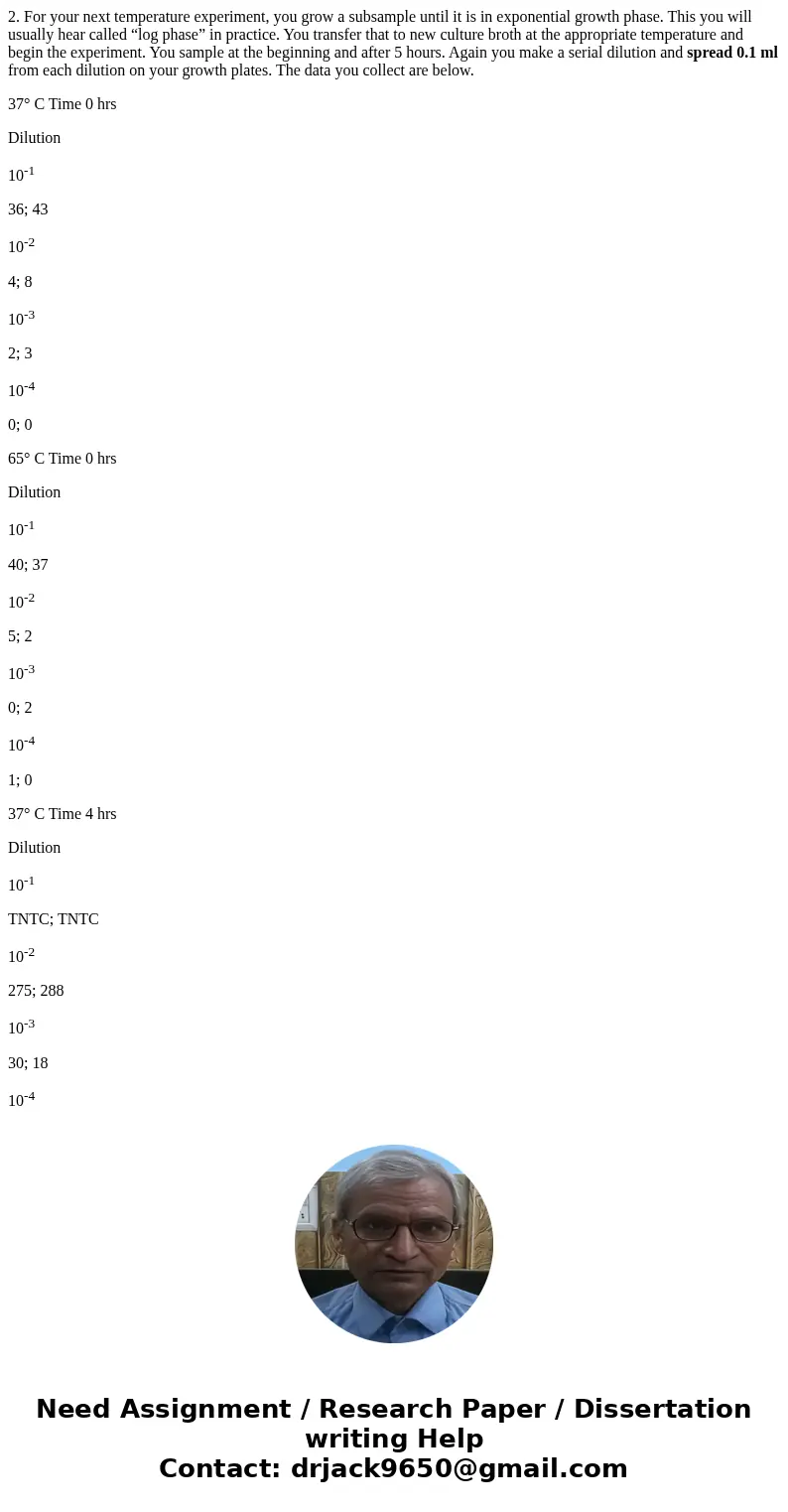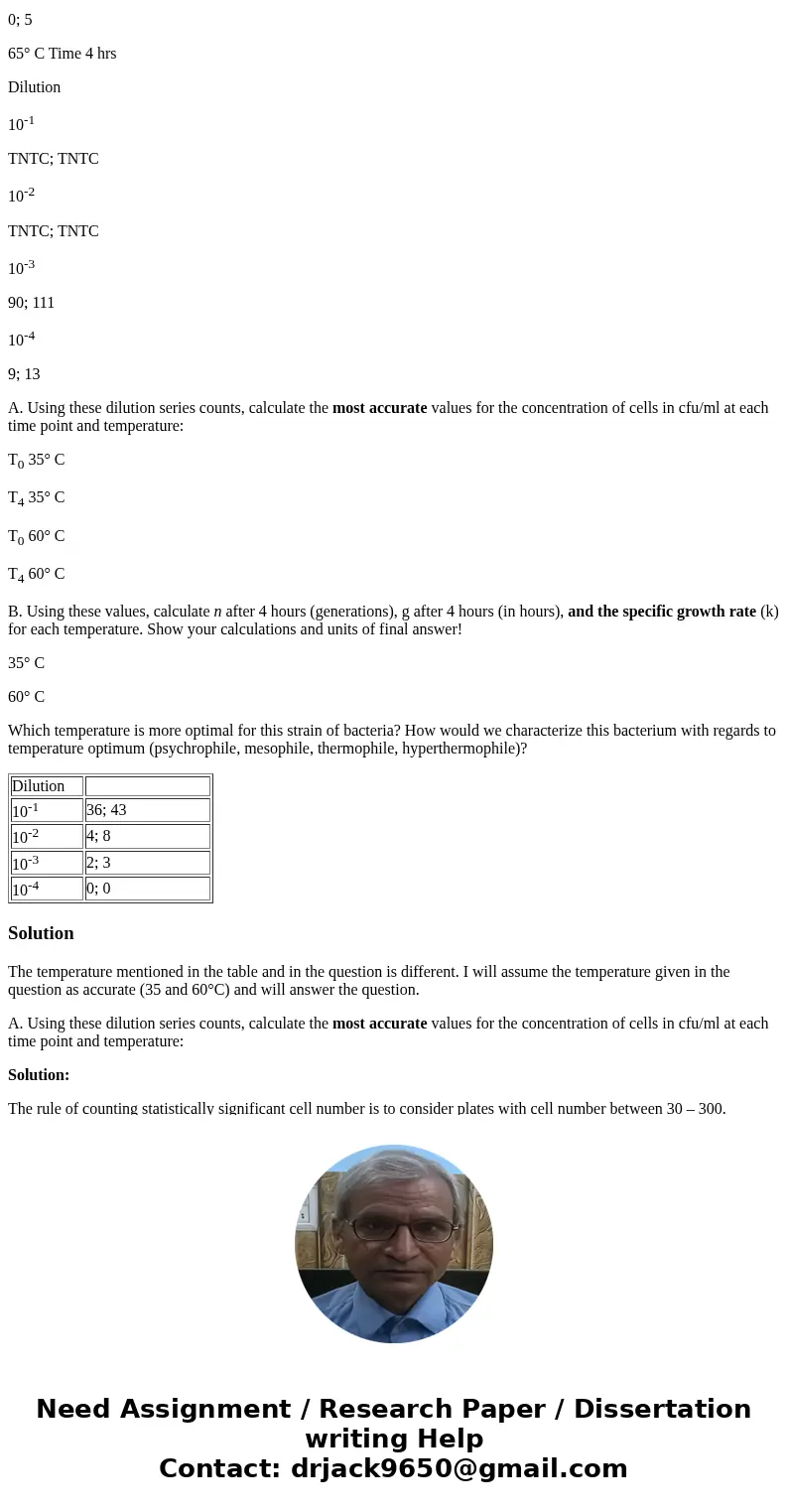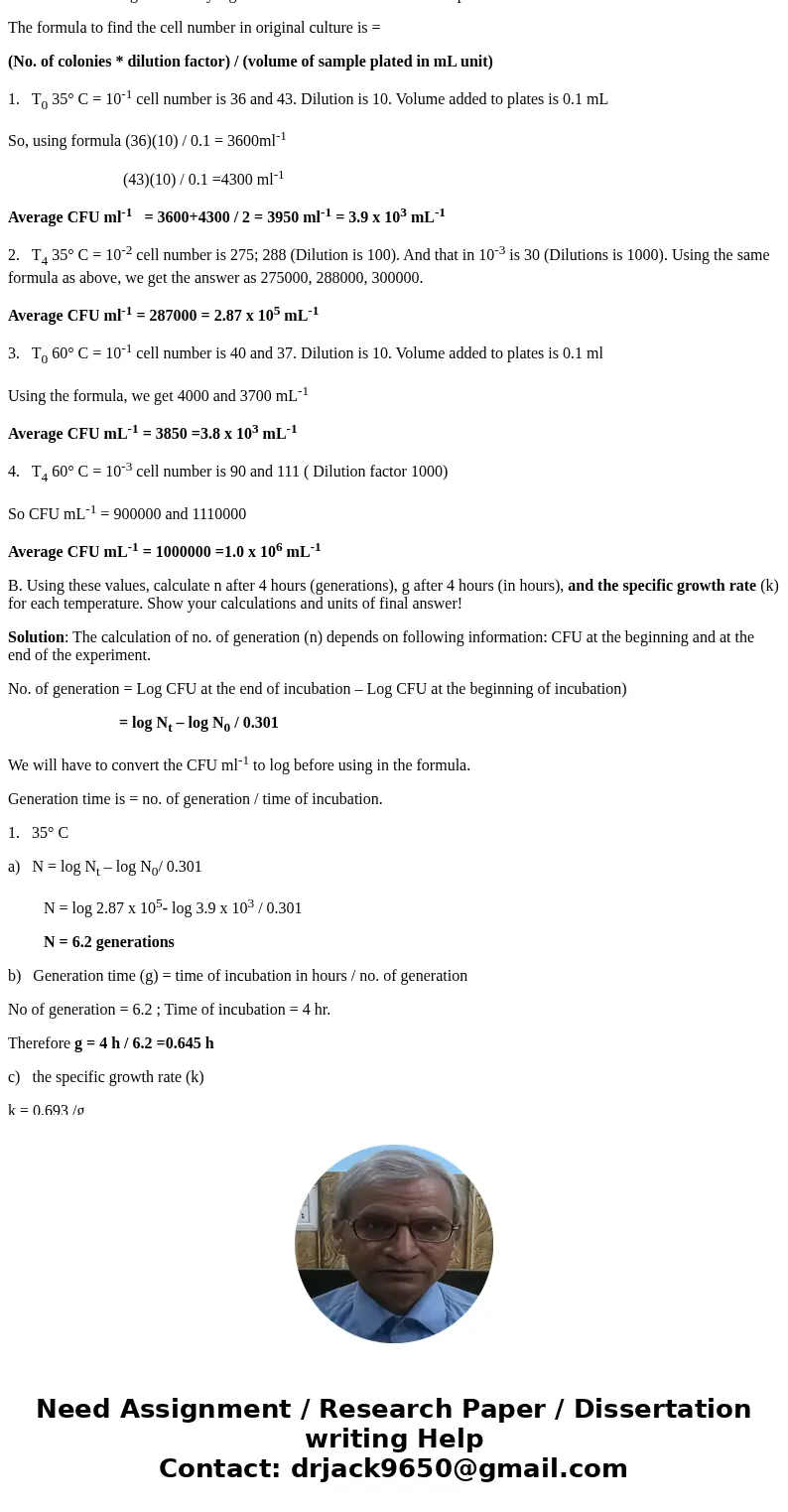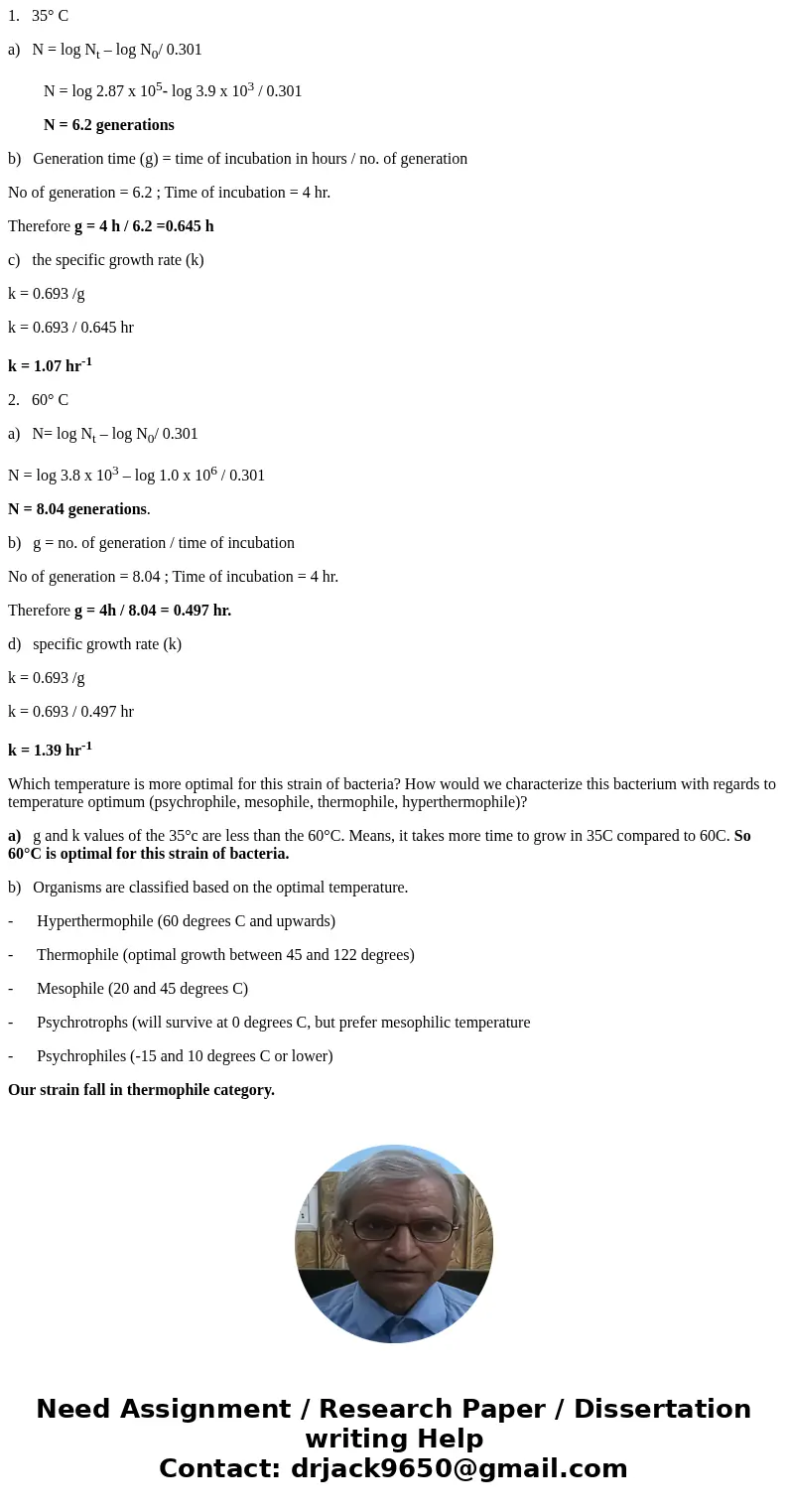2 For your next temperature experiment you grow a subsample
2. For your next temperature experiment, you grow a subsample until it is in exponential growth phase. This you will usually hear called “log phase” in practice. You transfer that to new culture broth at the appropriate temperature and begin the experiment. You sample at the beginning and after 5 hours. Again you make a serial dilution and spread 0.1 ml from each dilution on your growth plates. The data you collect are below.
37° C Time 0 hrs
Dilution
10-1
36; 43
10-2
4; 8
10-3
2; 3
10-4
0; 0
65° C Time 0 hrs
Dilution
10-1
40; 37
10-2
5; 2
10-3
0; 2
10-4
1; 0
37° C Time 4 hrs
Dilution
10-1
TNTC; TNTC
10-2
275; 288
10-3
30; 18
10-4
0; 5
65° C Time 4 hrs
Dilution
10-1
TNTC; TNTC
10-2
TNTC; TNTC
10-3
90; 111
10-4
9; 13
A. Using these dilution series counts, calculate the most accurate values for the concentration of cells in cfu/ml at each time point and temperature:
T0 35° C
T4 35° C
T0 60° C
T4 60° C
B. Using these values, calculate n after 4 hours (generations), g after 4 hours (in hours), and the specific growth rate (k) for each temperature. Show your calculations and units of final answer!
35° C
60° C
Which temperature is more optimal for this strain of bacteria? How would we characterize this bacterium with regards to temperature optimum (psychrophile, mesophile, thermophile, hyperthermophile)?
| Dilution | |
| 10-1 | 36; 43 |
| 10-2 | 4; 8 |
| 10-3 | 2; 3 |
| 10-4 | 0; 0 |
Solution
The temperature mentioned in the table and in the question is different. I will assume the temperature given in the question as accurate (35 and 60°C) and will answer the question.
A. Using these dilution series counts, calculate the most accurate values for the concentration of cells in cfu/ml at each time point and temperature:
Solution:
The rule of counting statistically significant cell number is to consider plates with cell number between 30 – 300.
The formula to find the cell number in original culture is =
(No. of colonies * dilution factor) / (volume of sample plated in mL unit)
1. T0 35° C = 10-1 cell number is 36 and 43. Dilution is 10. Volume added to plates is 0.1 mL
So, using formula (36)(10) / 0.1 = 3600ml-1
(43)(10) / 0.1 =4300 ml-1
Average CFU ml-1 = 3600+4300 / 2 = 3950 ml-1 = 3.9 x 103 mL-1
2. T4 35° C = 10-2 cell number is 275; 288 (Dilution is 100). And that in 10-3 is 30 (Dilutions is 1000). Using the same formula as above, we get the answer as 275000, 288000, 300000.
Average CFU ml-1 = 287000 = 2.87 x 105 mL-1
3. T0 60° C = 10-1 cell number is 40 and 37. Dilution is 10. Volume added to plates is 0.1 ml
Using the formula, we get 4000 and 3700 mL-1
Average CFU mL-1 = 3850 =3.8 x 103 mL-1
4. T4 60° C = 10-3 cell number is 90 and 111 ( Dilution factor 1000)
So CFU mL-1 = 900000 and 1110000
Average CFU mL-1 = 1000000 =1.0 x 106 mL-1
B. Using these values, calculate n after 4 hours (generations), g after 4 hours (in hours), and the specific growth rate (k) for each temperature. Show your calculations and units of final answer!
Solution: The calculation of no. of generation (n) depends on following information: CFU at the beginning and at the end of the experiment.
No. of generation = Log CFU at the end of incubation – Log CFU at the beginning of incubation)
= log Nt – log N0 / 0.301
We will have to convert the CFU ml-1 to log before using in the formula.
Generation time is = no. of generation / time of incubation.
1. 35° C
a) N = log Nt – log N0/ 0.301
N = log 2.87 x 105- log 3.9 x 103 / 0.301
N = 6.2 generations
b) Generation time (g) = time of incubation in hours / no. of generation
No of generation = 6.2 ; Time of incubation = 4 hr.
Therefore g = 4 h / 6.2 =0.645 h
c) the specific growth rate (k)
k = 0.693 /g
k = 0.693 / 0.645 hr
k = 1.07 hr-1
2. 60° C
a) N= log Nt – log N0/ 0.301
N = log 3.8 x 103 – log 1.0 x 106 / 0.301
N = 8.04 generations.
b) g = no. of generation / time of incubation
No of generation = 8.04 ; Time of incubation = 4 hr.
Therefore g = 4h / 8.04 = 0.497 hr.
d) specific growth rate (k)
k = 0.693 /g
k = 0.693 / 0.497 hr
k = 1.39 hr-1
Which temperature is more optimal for this strain of bacteria? How would we characterize this bacterium with regards to temperature optimum (psychrophile, mesophile, thermophile, hyperthermophile)?
a) g and k values of the 35°c are less than the 60°C. Means, it takes more time to grow in 35C compared to 60C. So 60°C is optimal for this strain of bacteria.
b) Organisms are classified based on the optimal temperature.
- Hyperthermophile (60 degrees C and upwards)
- Thermophile (optimal growth between 45 and 122 degrees)
- Mesophile (20 and 45 degrees C)
- Psychrotrophs (will survive at 0 degrees C, but prefer mesophilic temperature
- Psychrophiles (-15 and 10 degrees C or lower)
Our strain fall in thermophile category.




 Homework Sourse
Homework Sourse